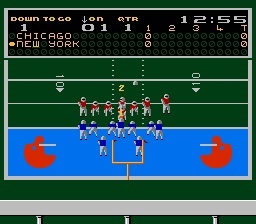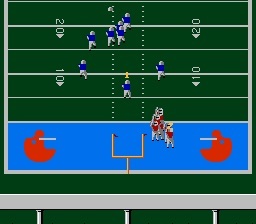This One’s Not For John: On the NES Port of John Elway’s Quarterback
November 12, 2011 at 2:35 pm | Posted in Reviews | 6 CommentsTags: Commodore 64, John Elway, John Elway's Quarterback, NES, Nintendo, Retro Gaming, Sports games, sports video games, Tradewest, video games
“This one’s for John” is what Denver Broncos owner Pat Bowlen exclaimed (in a somewhat canned tone) while holding the Lombardi trophy after the Super Bowl win in 1997 over the Green Bay Packers. This was the ultimate retribution as Elway had been drafted #1 overall (and then traded from the Colts after refusing to sign) and had lost his three prior Super Bowl appearances. He never had a running game or much of a defense but was always known for his 4th quarter comebacks, most notably at the expense of the Cleveland Browns in two AFC Championship encounters. While his career would end in storybook fashion after another Super Bowl win in 1998, Elway’s losing streak (after losing a third Super Bowl in four years in 1989) would not be helped by his soon-to-be mainstream video game title. Synonymous with being a choker, Elway’s name was already being used for the same game in the arcades and other home computer systems, until Tradewest came along looking for a quick buck with their first NES sports game. Taking what was already produced by Virgin and porting it to the NES, Tradewest would license and distribute one of the worst sports games ever for the Nintendo Entertainment System in John Elway’s Quarterback.
Growing up, I didn’t have a NES (initially). We had the Atari 2600 at my grandparents and we had a huge library of games for the Commodore 64 at home – including John Elway’s Quarterback. Being restricted to computer games (that I believed at the time just weren’t the same) but swept up in Nintendo-mania, I spent a lot of weekends at friend’s houses and spent my weekdays daydreaming about Super Mario Bros 2 and Mike Tyson’s Punch-out. The best football game at the time for the NES, Tecmo Bowl, had been released in early 1989, but despite reading about it and wishing someone had it, we were limited as 10 year-olds to what our parents or holidays granted us. That limitation left us playing a lot of John Elway’s Quarterback.
In addition to being in the arcades (and costing you a quarter for each football quarter) John Elway’s Quarterback was also available on the previously mentioned Commodore 64, the PC (MS-DOS of course), the Apple IIGS, the Amstrad GPC, and the ZX Spectrum (the last two being systems you learn about by reading Retro Gamer magazine). Tradewest, responsible for the NES adaption of John Elway’s Quarterback along with Rare of all groups, was best known for Double Dragon, Battletoads, Battletoads & Double Dragon, and one would assume the upcoming Battletoads 3D on the Wii U (they actually no longer exist after being absorbed by Midway in the mid-nineties).
In John Elway’s Quarterback there are only cities to select when picking a team (there is no NFL license) but every team is the same and there no fake player names or numbers to distinguish anyone on the field. There isn’t even an effort to differentiate the teams by uniform color; every game is red vs blue regardless of who you select. There are no stats, no timeouts, and worst of all no pausing the game. The sound is an annoying “charge” midi which is hard to make out. There is no other music in-game, you play in dead silence except for the “charge” beeps. There are two unique items to this game that are worth mentioning though. There are nine offensive plays and six defensive plays, not including special teams options, and you have the option to reverse the play, essentially doubling the playbook on offense. This was definitely new for the time and even though the play selection didn’t visually flip, you could always tell where the play was going by the man in motion pre-snap. Passing is also different in that you hold down the B button and move an on-screen arrow to where you want to throw the ball. This is the first evidence of leading a receiver in a video game, however, the mechanics are screwy as you’re trying to move the arrow, while simultaneously avoiding a fierce pass rush. You end up always racing back from the line of scrimmage and throwing off your back foot ala Jim Everett, or for a more recent example, Kevin Kolb. The running plays in the game are John Elway-centric: a sneak, draw and bootleg (there are no handoffs) but the the ones that take a while to set up are very difficult to pull off. The passing plays were stuck in the back of my sports gaming subconscious for years because I instantly remembered the passing routes on the Lookie, Post and Bomb plays once I started replaying. Please keep in mind this was the only football game I had on the Commodore 64.
John Elway’s Quarterback is at its core a multiplayer-only arcade game and the replay value amongst friends is limited after a handful of games. The single player perspective on the NES is where the game gets in the discussion of “Worst Game Ever.” Now, sports games don’t necessarily need a narrative. Sports inherently have a story and drama built-in so using your imagination and dramatically calling the play-by-play by yourself can make a game passable – especially back in the late ’80s. John Elway’s Quarterback on the NES has the laziest single player I’ve ever witnessed. Regardless of the city you select, you face New York first (and if you select New York, you play San Francisco). After you dismiss the pedestrian single player CPU A.I. you are taken back to the main title screen. In starting another game, and using the same team, you face New York again! There is literally no advancement or single player goals. You can’t even face cities like New England, Pittsburgh or San Diego (even though they are generically the same)! On the Commodore 64, you got a random team so there was at least a little surprise when pretending each team was their NFL counterpart and keeping records for yourself.
The A.I. in John Elway’s Quarterback is as bad as one could expect given the efforts put into the single player setup. The CPU rarely runs and every pass play either results in a sack (offensive line play is nonexistent for both teams), completion in traffic or interception (and there are a lot of interceptions). In playing through a number of games, I never saw an incompletion by the CPU. From a special teams standpoint, despite 4th and 13 from their own 35, the logic of the A.I. is to go for it. To top things off, there is a “special” play built into the game which is the very definition of cheapness. Remember the ability to select “Reverse Play?” Being an arcade port, you have a limited time to select a play so whichever play is highlighted when your time is up is the play ran. If you leave “Normal Play” highlighted (clicking would make it Reverse Play) you’ll run a play that is essentially a WR screen. You get no offensive line support (its worse than normal with this play) but if you quickly drag your arrow to the left and pass, a WR will grab the ball and have warp speed in which to easily race for a touchdown. I stumbled onto this play when trying to figure out how to snap the ball (you press down – not a button), quickly hitting “A” and flipping it to a WR who raced around to the sideline for a score. Not being sure what I witnessed, I hit up GameFAQs and sure enough – a special glitch type play to make the single player more lopsided and multiplayer more infuriating with friends (unless rules are established to not use this). Oddly enough, my surpressed memories of this game started coming to the surface as I wrote this article and I did recall racing around the field in circles with these superpowered players (only the NES version in my experience).
I had a lot of feelings of nostalgia going into replaying this title. I vividly remember the times I spent holding an Atari joystick (this was one of the few games that works with just one button) sitting on my bedroom floor playing John Elway’s Quarterback on the Commodore 64. The game ran incredibly slow for some reason and I credit my future patience with bad video games to sitting through John Elway’s Quarterback games that took hours to play. I recalled the NES title (which took about 15-20 minutes to play) being brighter and with the benefit of the perspective of being ten years-old, a decent amount of fun – even if we just ran the Bomb play and played Prevent on defense against each other. It had been twenty years since I picked up this title and much like reliving the early frustrations of John Elway’s career, this one was better left in the past.
6 Comments »
RSS feed for comments on this post. TrackBack URI
Leave a comment
Blog at WordPress.com.
Entries and comments feeds.







This is best as a footnote to the main article:
After re-discovering the glitch, I thought it would be neat to try for a margin of victory record on Twin Galaxies. On my first attempt, I did finish tied for fourth (42 pt win). I think there is great potential in trying to set video game records on NES sports games that no one plays 🙂
Comment by retrosportsgamer— November 12, 2011 #
My favorite search referral for the site so far is “John Elway’s worst game” through Google. Not what you were looking for, but the search isn’t technically wrong.
Comment by retrosportsgamer— December 3, 2011 #
[…] by Rare and licensed by Tradewest for the NES. How did this adaption turn out? Read more at Retro Sports Gamer World Advertisement GA_googleAddAttr("AdOpt", "1"); GA_googleAddAttr("Origin", "other"); […]
Pingback by John Elway’s Quarterback (Not Tim Tebow) « OGR— January 22, 2012 #
[…] colors, which as you can see with Joe Montana Football, isn’t always a given. Just like John Elway’s Quarterback for the NES, and despite being released in 1990, every game in Joe Montana is the same red vs. […]
Pingback by Retro Showdown: Walter Payton vs. Joe Montana on the Sega Master System « Retro Sports Gamer World— February 12, 2012 #
[…] pack-ins by EA in the early 90s and I went on a terrific rant against Tradewest for their work in this and another Tradewest published NES game which I also consider one of the worst sports games of […]
Pingback by Retro Sports Games Roundtable « Retro Sports Gamer World— May 14, 2012 #
John Elway’s Quarterback is a horrible game but I believe more playable than 10-Yard Fight
Comment by Frostybros— January 23, 2013 #